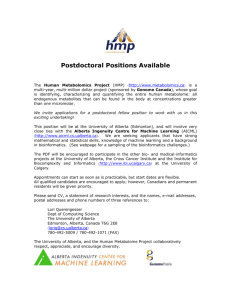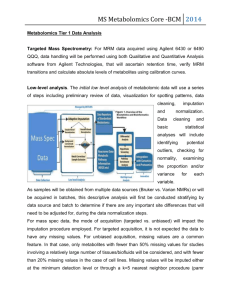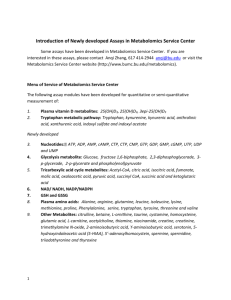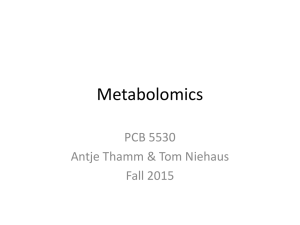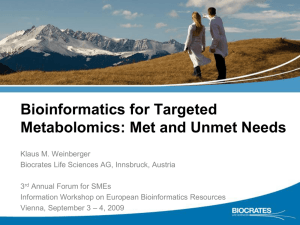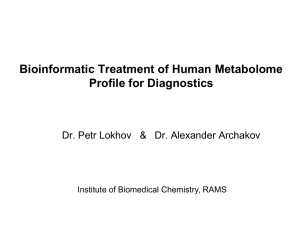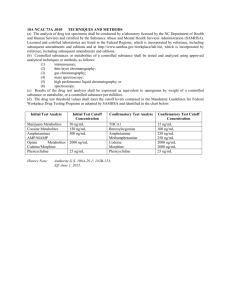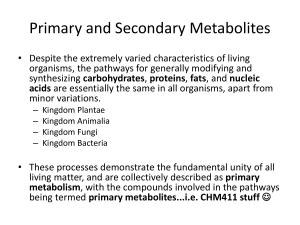How metabolism became metabolomics
advertisement
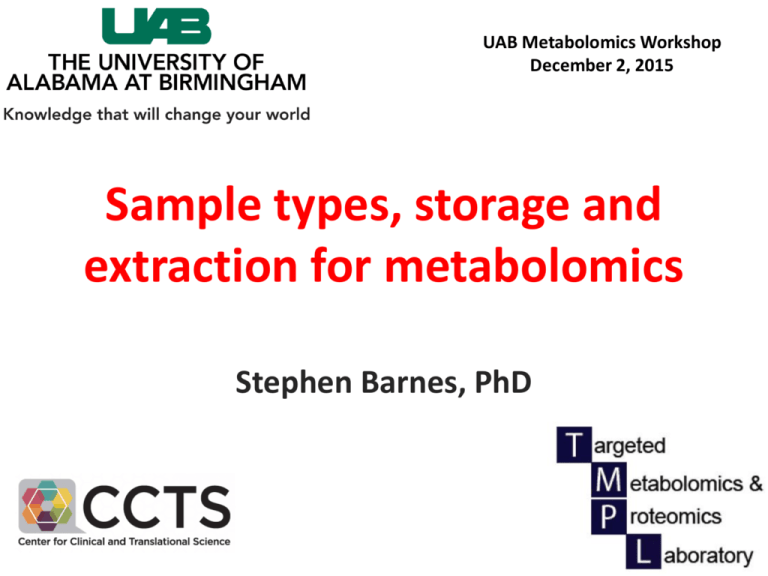
UAB Metabolomics Workshop December 2, 2015 Sample types, storage and extraction for metabolomics Stephen Barnes, PhD Sample selection • This is the most important part of a metabolomics experiment • The samples should be collected according to a written, agreed upon protocol • Sample types – Biofluids (whole blood, plasma, serum, CSF, sputum, follicular fluid, bile, duodenal fluid, fecal water, lung lavage, aqueous humor) – Tissues (brain, liver, heart, kidney, adrenals, muscle, ovaries, testes, lung) – Cells (cancer cells, cardiomyocytes, yeast, oral bacteria) – Food Blood • A very important issue is the timing of the collection – Many components of the circulating metabolome come from the foods that are eaten by the subject – Unless the question concerns analysis of the postprandial metabolome, it is best if the sample taken is after an overnight fast (animals and subjects) • As for tissues, metabolites can change after collection • Whole blood should be immediately placed on ice and then frozen in liquid N2, or stored in a -80oC freezer Plasma and serum • Plasma requires either EDTA (for LC-MS) or heparin (for NMR) to prevent coagulation – Treated blood is centrifuged to sediment the red cells and monocytes – Plasma is aspirated and quickly frozen at -80oC • Serum requires time for full coagulation – This involves a period at room temperature • Keep constant, but be wary of subjects with slow clotting times – Clotted blood is centrifuged at 4oC to separate serum – Collected sera are stored at -80oC in 0.5 ml aliquots Other biofluids • Urine – Best if a 24 h or longer total urine collection is done • Rodents – collect directly into a beaker embedded in dry ice • Patients - store at 4oC during the collection period • Additives (ascorbic acid, CHCl3) – Alternative, a spot urine but collect data on what food had been eaten/any drugs taken prior to collection – Centrifuge to remove precipitates – Store at -80oC – Best if stored in 100 ml aliquots Tissues • The metabolome will change very quickly as soon as the sample is taken • Where possible, place immediately into liquid N2 before proceeding – Store at -80oC • Blood metabolites contaminate tissues – For animal studies, expose organ and flush its venous blood supply with ice-cold, physiological saline – Then snap-freeze tissue with flat-faced tongs dipped in liquid N2 Anesthetics/analgesics • Prior to sampling of blood, other biological fluids and tissues, it may be necessary to use an anesthetic. – The time to anesthetize an animal will alter the metabolome – Ideal method is to use a guillotine, fast tissue excision and liquid N2 • If the IACUC-approved protocol requires an analgesic, it (and its metabolites) will be present – Discuss with IACUC possible alternative methods Documenting patient therapeutics • Most patients in a study are taking additional drugs or dietary supplements that add compounds to the metabolome • These xenobiotics also undergo metabolism – – – – Phase I Phase II Microbiome-based Also regulate the microbiome which in turn may alter the metabolism • Watch out for patients taking antibiotics Extracting the metabolome “From H2 gas to ear wax” We’ve been asked to analyze fecal gases! • No single extraction procedure exists that is optimal for all metabolites • The default method is very cold methanol:water (4:1) • If the analytes in the metabolome are known, then more hydrophobic solvents can be used • pH affects the extraction – acid, neutral and basic Internal standards • Isotopically labeled metabolite standards are essential to monitor recovery during the extraction process – Same amount added to all samples – 13C is better than 2H, but is more expensive – Need to increase the mass by 4 Da compared to the unlabeled biological metabolite to avoid natural abundance 13C – A typical set would be 13C4-succinate, 13C16palmitate and L-13C9-tyrosine Extracting biofluids Protein precipitation with acetone or methanol • Plasma partitioned between chloroform-methanol (lower phase) and water (upper phase) • Proteins precipitate at the interface • Lower phase contains lipids • Upper phase has more hydrophilic metabolites Extracting tissue • Metal percussion mortar cooled in liquid N2 • Grind tissue at <-100oC • Pour pulverized tissue into cold extraction solvent • Glass tissue homogenizer cooled in liquid N2 • Pestle is PTFE or glass • Can be very small • Ultrasonication after adding solvent http://www.metabolomicsworkbench.org/protocols/index.php for specific protocols The LC-MS platform • Metabolites are separated on the basis of their hydrophobicity (using a reverse-phase column) or hydrophilicity (HILIC column) using solvent gradients • UPLC – High resolution chromatography (human samples) • NanoLC – for precious or low volume samples Column etched on a chip nanoLC placed in a temperature-controlled Nanoflex™ All about reproducibility The mass spectrometer • Ions – These can be +ve and –ve (require separate LC runs) – Several thousands can be measured – Some are adducts of the same metabolite • [M+H]+, [M+Na]+, [M-H]-, [M-H.COO]- • Untargeted LC-MS – In this mode need a (very) fast analyzer for MS and MSMS analyses – Time-of-flight (TOF) is the best • New instrument from Sciex can collect data at 5 msec intervals – Orbitrap/FT-MS have better mass accuracy, but not at this speed • Used in follow up experiments where more time is available Doxorubicin Total ion current of all patients Searching for doxorubicin – found in just one patient 13C-isotope peaks The metabolites of doxorubicin Metabolomics and drugs in patients Analysis with MZmine Untargeted metabolomics better defines the patient in a clinical study Imaging Mass Spectrometry – rat lens ` Extracted m/z values: the image “aA-crystallin” (?) (6,409 Da) Merged images m/z = 19,822 Da m/z = 6,409 Da Merge m/z = 19,822 Da m/z = 6,409 Da Merge 100-day ICR/f rat 21-day ICR/f rat Light microscope image Full-length aAcrystallin (19,835 Da) Stella et al. IOVS 51: 5151 (2010)
